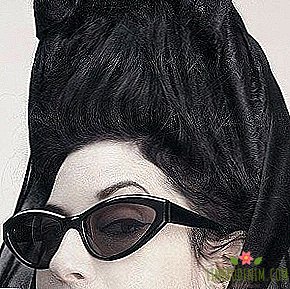Why do people change their bodies beyond recognition
PEOPLE TRYING TO CHANGE OUTSIDE from ancient times. Often, such procedures had a ritual and symbolic meaning: scarification, extended with the help of neck rings and sawed teeth could be the standard of beauty and a sign of the passed initiation; there is an opinion that sometimes women tried to make them “unattractive”, so that they would not be kidnapped. In the modern world, changes in the body have long lost their traditional meanings and acquired a lot of new meanings. Some of them, like piercings or tattoos, have long become familiar, others still seem strange and alien to us. We understand why people strive to radically change their bodies today - and where it leads us.
Text: Alisa Zagryadskaya

Aesthetics
Despite the dominance of the standard images in advertising and media, ideas about what can be considered beautiful in the modern world are very wide. At the same time, some modifications of the appearance “for beauty” are rooted in the cultural consciousness more firmly than others: be it plastic surgery or makeup - everywhere there is a separation between the generally accepted (weight loss, more “correct” facial features and proportions) and the unfamiliar, because does not fit into familiar standards.
For example, in addition to the "traditional" makeup, which is designed to emphasize the "dignity" and hide the "flaws", there are others that serve completely different purposes. This is how, for example, drag-makeup (or rather, make-up) works, capable in visual hands to visually adjust the structure of the face, create a new shape of lips and eyebrows - all this does not look like traditional "femininity" and resembles complete transformation, so that a person becomes almost unrecognizable "outside the image". The drag techniques moved to more familiar and everyday make-up - for example, sculpting is used to visually change the proportions of the face. There is even a body contouring that allows you to “try on” another figure and proportions without much difficulty.
The decision to go to the gym, build muscle or greatly change body weight can also be a way of modification. Of course, physical exercise is not always associated with the desire to change appearance - there is still a love for sport, the need for movement or the desire to do health. But it is impossible not to notice how the appearance changes after intensive exercises involving certain muscle groups or suggesting what is called drying (intensive work on muscle relief or weight loss). Sometimes this is the goal - remember the professional bodybuilding, which implies that the body is not just "pulling up", and growing muscle mass and increase the volume of the body. All this does not fit into the traditional canons of beauty and generally accepted - women bodybuilders often receive comments about "unfemininity"
Another version of the changes dictated by aesthetic preferences, for example, the Korean beauty industry, is creating the desired image with the help of plastic surgery. In Korea, very strict appearance standards reign, thanks to which the plastic surgery industry flourishes - especially love blepharoplasty (changing the shape of the eyelids, eye shape) and operations that correct the lower jaw, making the chin sharper and smaller. As for global practice, according to ISAPS, the most popular operations for men are blepharoplasty, gynecomastia surgery to reduce the mammary glands, rhinoplasty and liposuction. In women, the leading positions are occupied by labioplasty (changing the shape of the labia), breast augmentation, as well as “tightening” of different parts of the body.
Changing facial features, many still choose celebrities as a model - for example, according to the same ISAPS, many of those who choose rhinoplasty want to be like Megan Markle. Some go even further and actually abandon their own face to achieve maximum similarity - for example, the Brazilian Rodrigo Alves, who is called the "living doll Ken."
On the one hand, plastic surgery makes it possible to take control of your own body: to look different, simply because a person finds it interesting or wants to bring personal ideas of beauty to life. On the other hand, it is often to the idea of meeting the generally accepted ideal that a person is pushed by society, which imposes the idea that appearance needs to be “corrected”. To understand where the boundary between the desire for free expression and the painful rejection of oneself — bodily dysphoria — is not so simple. It is even more difficult to answer the question whether it is worth eliminating dysphoria by changing the body, and not the attitude towards it.

Social protest
It seems that a person does not have a more personal thing than his own body, but traditionally it has always been considered as a property of the society - after all, a person is always a part of it. Therefore, a non-standard approach to your own body, the rejection of well-established symbols still cause a negative reaction: today there are many people who will tell you in which ear a man "can" wear earrings and what this or that tattoo actually means.
In the Western Christian tradition, for example, body decoration was associated with barbarism and paganism, and therefore with vices. For example, Christ's tormentors in Bosch’s painting “Carrying the Cross” are depicted with earrings and chains on his face - this symbolized the violation of the “image of God”. Such an approach to everything “unnatural” and changing a person’s habitual image has been maintained in culture for a long time — for example, in medieval Europe, earrings were a symbol of belonging to poor classes.
It is logical that there are those who radically change their appearance, just to oppose themselves to society - and this idea flourished in the twentieth century. In the USA of the 70s, freedom-loving Californians popularized piercing and tattoos. Since 1977, the magazine "PFIQ" ("Piercing Fans International Quarterly") began to be published, dedicated to the piercer. In the 80s, lovers of bodimodifikatsii began to actively master the practices, both borrowed from the traditions of different nations, and fundamentally new ones: numerous tattoos and piercings, scarification, elven ears, snake tongue, horns, toothing. Several years ago even bagels under the skin came into fashion.
Today, the usual tattoos and piercings will not surprise anyone, but the drawings covering the whole body are still perceived as something strange. Rick Genest, also known as Zombie Boy, for example, said that he liked to be different from others - and he was always fascinated by tattoos. He began to make them from the age of sixteen, after a brain tumor was removed from him - according to him, it seemed completely logical to beat dark tattoos in that state. As a result, the whole body was covered with a skeleton painting, including the face. Jenest always liked being called a freak: "I am proud that I am a freak. And yes, please look at me, I like it."
Elaine Davidson, according to the Guinness Book of Records, is the woman with the largest number of body and body piercings in the world — because of the jewelry on her skin, it is difficult to make out her facial features. A woman does everything new and new piercing, because she is striving for new records - but her image shows how the society, against which it goes, can still relate to this strange appearance. She lives in Edinburgh and claims that she is afraid of returning to her native Brazil because of her appearance causing an aggressive reaction from people - she is afraid that she will be robbed or attacked.
For some "professional freaks," changing the body is a rebellion against the very human form. For example, “dragon woman” Eva Tiamat Medusa, who also proudly bears the status of the most body-modified transgender woman in the world, claims that “she didn’t want to die, looking like a man.” When she was five, her parents threw her at night in the fields — there she was impressed by the rattlesnakes that Eva Tiamat Medusa strives to be like. Subsequently, she became a successful banker, but she had to part with a career because of HIV. It was then that the image of the "dragon woman" began to appear, which, due to the abundant tattoos, horns, forked tongue, smooth nose and lack of auricles, resembles a representative of another species - the woman considers not only the biological mother and father, but also snakes to be her parents. "Despite everything beautiful and good in people, in comparison with other creatures on the planet, they are the most destructive, aggressive creatures that kill each other for no particular reason or because of contrived causes. People have always been the main cause of pain in my life "she says.

Art and ideological manifesto
Radical changes in appearance are often associated with dysmorphophobia, a disorder in the perception of one’s own body. However, while some medicalize the situation, others insist that everyone is free to use the body as plastic material for art projects - or to create an appearance in accordance with their own ideas. And the more eroded the standards of beauty and the notion of "decent" in appearance, the more around freedom.
Turning your own body into a canvas or into a work of art is not such a new invention. Futurists also suggested making the image of a person as “author's” as possible, starting with clothes and ending with the body. Mikhail Larionov and Ilya Zdanevich advised both men and women to wear makeup - to color themselves, creating small pictures on their faces. In a sense, artists predicted today's popular free makeup, which is designed not to "hide flaws", but to reflect the mood and idea.
However, the ideology of changing oneself for the sake of artistic expression reached a special acuteness at the end of the twentieth century, with the development of technology and the emergence of Saints Art, a trend that blends science and art. The two most famous artists who use body to express ideas are ORLAN and Stelarc.
It cannot be said that the Australian artist and professor of robotics Stelarc changed his whole body, but here it is impossible not to mention it. Stelarc conducted a series of performances with hanging on hooks (in particular, he flew over the city on a tower crane), attached a mechanical third hand and made himself a third ear. The skeleton implanted under the skin looks very convincing - but most importantly, the artist plans to add an electronic “stuffing” there and broadcast the sounds he hears.
“The body is an object in which design evolution takes place. We are already chimeras: meat, metal, codes. I wonder what happens when biological material interacts with technology and virtual reality,” says Stelarc. As the American critic Mark Dery notes, the artist usually speaks of the “body” rather than “my body”: in his performances we are talking about physicality in general, about posthuman practices. However, one of the best stories about Stelarko emphasizes how deeply the idea that the body belongs to society is sewn into our cultural code: the artist, famous for the whole world by his radicalism, confessed that he was hiding the third ear from his mother, because he thought that she would not understand.
The artist ORLAN has changed beyond recognition - she conducted a series of performances, within the framework of which she corrected her appearance with plastic operations - during them the artist was conscious and commented on what was happening. Many say that this is how she got the chin of Venus Botticelli, the nose of Psyche Jean-Leon Gerome, the forehead of Mona Lisa da Vinci, although the artist herself denies this. ORLAN emphasizes that she, who grew up in a nudist family, had no problems with perceiving her own body. "The reincarnation of Saint ORLAN" - a project that was done with a cool head for the study and deconstruction of cultural ideas about female beauty. Subsequently, ORLAN added a pair of growths-horns to her forehead, which, by mood, is covered with glitter.
According to art critic Irina Kulik, ORLAN embodies the ideas of cyberfeminism, wanting to exist not as a born, but as a woman of her own free will. With her art actions, she says that a person should go beyond the biological. Therefore, an artist’s own appearance is art. A couple of years ago, she accused Lady Gaga of plagiarism - allegedly violating intellectual property rights by copying her image in one of the clips. At the same time, ORLAN does not adhere to the concept of constancy: physical is something mobile that can change at any moment.
For centuries, the body was considered a rigid construct: we are born with it, and then we constantly check with the ideas of society about what it should be. But today, body changes are becoming more familiar - and motivation is no less important than actual actions and results. In a sense, the body has really become an instrument of modern art: without an explanation of what the author meant, it is sometimes difficult to immediately understand the meaning. But the main thing is that a person can really be a co-author of his body.
PHOTO: VH1, Thierry Mugler, ORLAN





